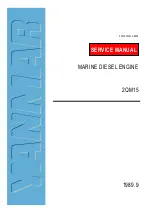
Rev. 3.0, 04/02, page 121 of 1064
5.3
Exception Handling Functions
5.3.1
Exception Handling Flow
In exception handling, the contents of the program counter (PC), status register (SR) and R15 are
saved in the saved program counter (SPC), saved status register (SSR), and saved general register
15 (SGR), and the CPU starts execution of the appropriate exception handling routine according to
the vector address. An exception handling routine is a program written by the user to handle a
specific exception. The exception handling routine is terminated and control returned to the
original program by executing a return-from-exception instruction (RTE). This instruction restores
the PC and SR contents and returns control to the normal processing routine at the point at which
the exception occurred. The SGR contents are not written back to R15 by an RTE instruction.
The basic processing flow is as follows. See section 2, Data Formats and Registers, for the
meaning of the individual SR bits.
1. The PC, SR, and R15 contents are saved in SPC, SSR, and SGR.
2. The block bit (BL) in SR is set to 1.
3. The mode bit (MD) in SR is set to 1.
4. The register bank bit (RB) in SR is set to 1.
5. In a reset, the FPU disable bit (FD) in SR is cleared to 0.
6. The exception code is written to bits 11–0 of the exception event register (EXPEVT) or to bits
13–0 of the interrupt event register (INTEVT).
7. The CPU branches to the determined exception handling vector address, and the exception
handling routine begins.
5.3.2
Exception Handling Vector Addresses
The reset vector address is fixed at H'A000 0000. Exception and interrupt vector addresses are
determined by adding the offset for the specific event to the vector base address, which is set by
software in the vector base register (VBR). In the case of the TLB miss exception, for example,
the offset is H'0000 0400, so if H'9C08 0000 is set in VBR, the exception handling vector address
will be H'9C08 0400. If a further exception occurs at the exception handling vector address, a
duplicate exception will result, and recovery will be difficult; therefore, fixed physical addresses
(P1, P2) should be specified for vector addresses.
Summary of Contents for SH7751
Page 39: ...Rev 3 0 04 02 page xxxviii of xxxviii ...
Page 89: ...Rev 3 0 04 02 page 50 of 1064 ...
Page 157: ...Rev 3 0 04 02 page 118 of 1064 ...
Page 193: ...Rev 3 0 04 02 page 154 of 1064 ...
Page 225: ...Rev 3 0 04 02 page 186 of 1064 ...
Page 253: ...Rev 3 0 04 02 page 214 of 1064 ...
Page 301: ...Rev 3 0 04 02 page 262 of 1064 ...
Page 343: ...Rev 3 0 04 02 page 304 of 1064 ...
Page 607: ...Rev 3 0 04 02 page 568 of 1064 ...
Page 671: ...Rev 3 0 04 02 page 632 of 1064 ...
Page 745: ...Rev 3 0 04 02 page 706 of 1064 ...
Page 767: ...Rev 3 0 04 02 page 728 of 1064 ...
Page 1061: ...Rev 3 0 04 02 page 1022 of 1064 NMI tNMIL tNMIH Figure 23 69 NMI Input Timing ...
Page 1069: ...Rev 3 0 04 02 page 1030 of 1064 ...
Page 1103: ...Rev 3 0 04 02 page 1064 of 1064 ...
















































